The Spanish Hotels – Paradores are a chain of historical luxury hotels located across Spain. They are owned and operated by the Spanish government’s tourism agency Paradores de Turismo de España.
There are currently 97 paradores hotels throughout Spain. The first parador opened in 1928 in the mountain town of Gredos. The government initiative aimed to promote tourism by converting historic buildings like castles, fortresses, monasteries, and palaces into unique hotels.
Today, paradores offer luxurious accommodations in beautifully restored landmark buildings. They showcase the history, culture, and nature of their destinations through architecture, design, gastronomy, and service. Staying in a parador allows travelers to fully experience the essence of Spain.
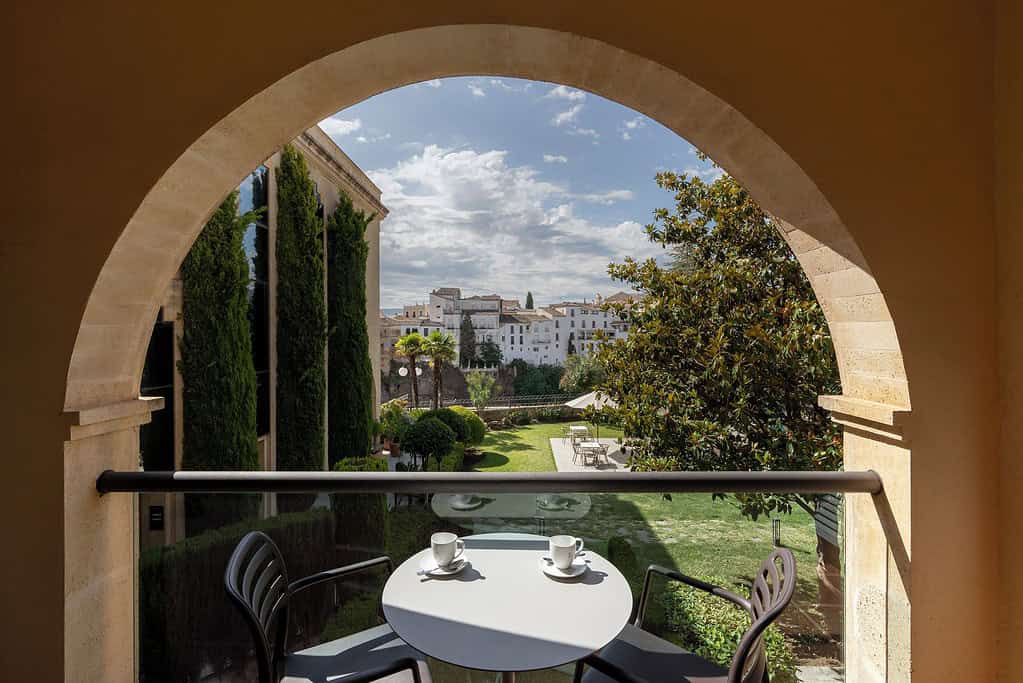
The hotels are located in many of Spain’s top destinations, from major cities to small charming towns and villages. They range from beachside resorts to mountain retreats to historic city hotels. Paradores highlight local architecture, art, culture and cuisine.
While owned by the government, paradores operate autonomously as a for-profit public company. They generate revenue to maintain the historic properties. Guests can expect 4 and 5 star service, amenities and dining. Paradores attract both Spanish and international travelers seeking a unique, cultural lodging experience.
*Note some of the links feature affiliate links. I only recommend items that I 100% love and think you will too!
Most Famous Spanish Hotels Paradores Locations
Spain’s state-owned paradores hotels are located in some of the most spectacular and historic sites across the country. Here are five of the most famous and breathtaking paradores locations:
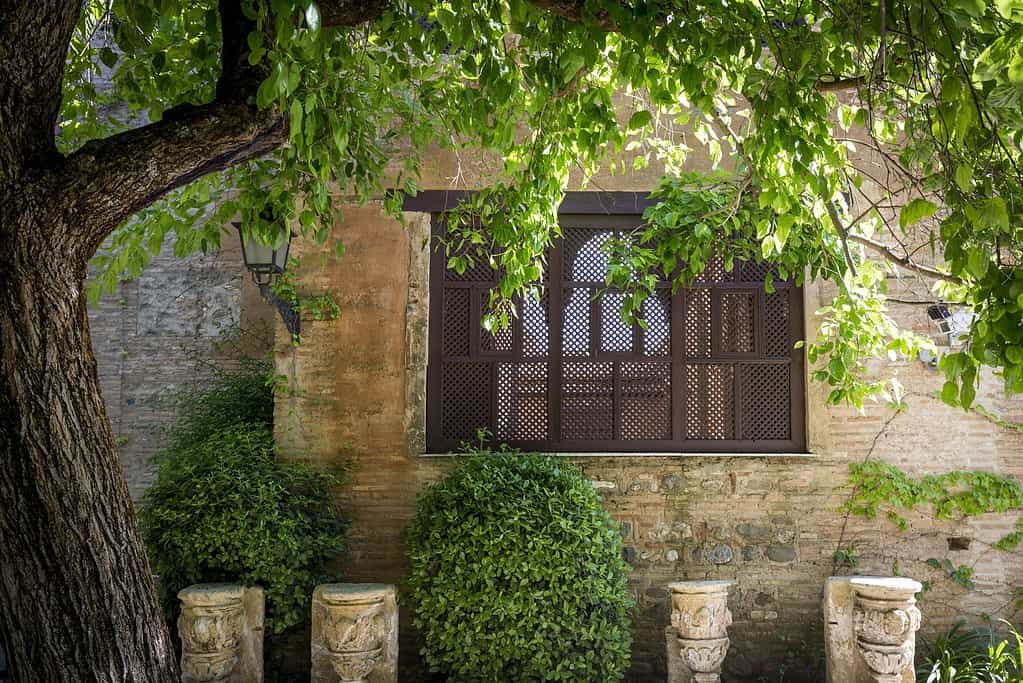
Parador de Granada in the Alhambra
Without a doubt, the most iconic parador is located within the grounds of the magnificent Alhambra palace and fortress in Granada. Staying in this parador lets you wander the Patio de los Leones and the Generalife gardens in the early mornings and late evenings when the crowds are gone. The views overlooking the palace grounds, the city of Granada, and the Sierra Nevada mountains are unbeatable.
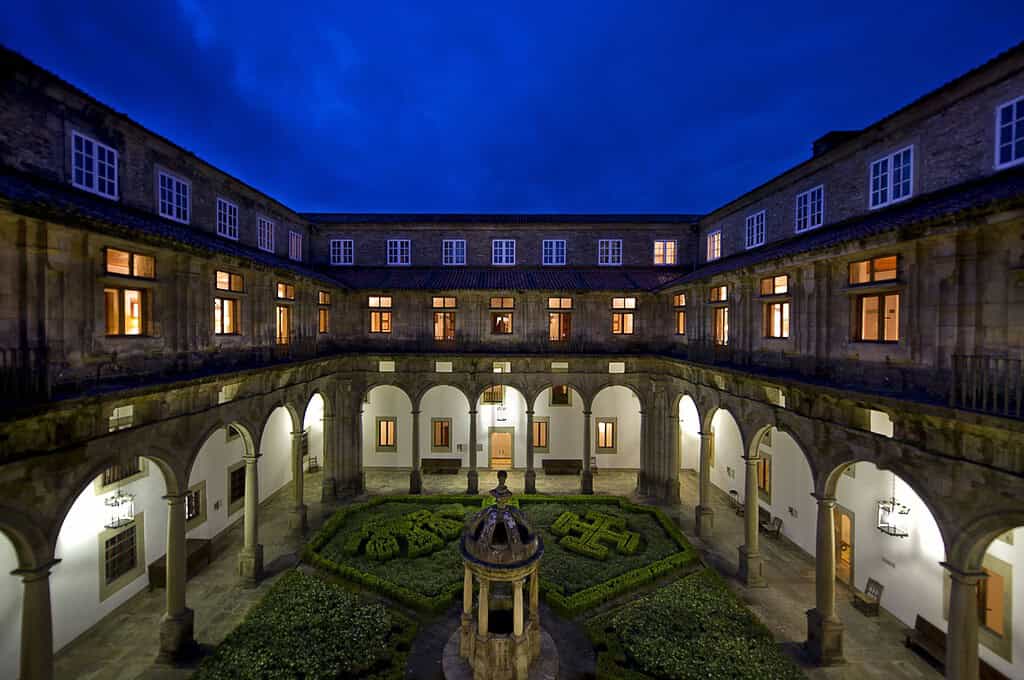
Parador de Santiago de Compostela next to the Cathedral
The parador in Santiago de Compostela sits on Obradoiro Square, directly across from the iconic Cathedral of Santiago de Compostela. The cathedral is the destination for pilgrims walking the Camino de Santiago trail through northwestern Spain. Staying at this parador allows you to easily visit the cathedral and watch the pilgrims arrive in the square.

Parador de Ronda on the Dramatic Cliffs
The parador in Ronda is located on the cliffs overlooking the Guadalevín River canyon, home to the historic Puente Nuevo bridge. The views from the parador’s rooms, restaurant, and terraces are spectacular. Ronda’s old town has charming plazas, historic sites like the oldest bullring in Spain, and excellent tapas bars.
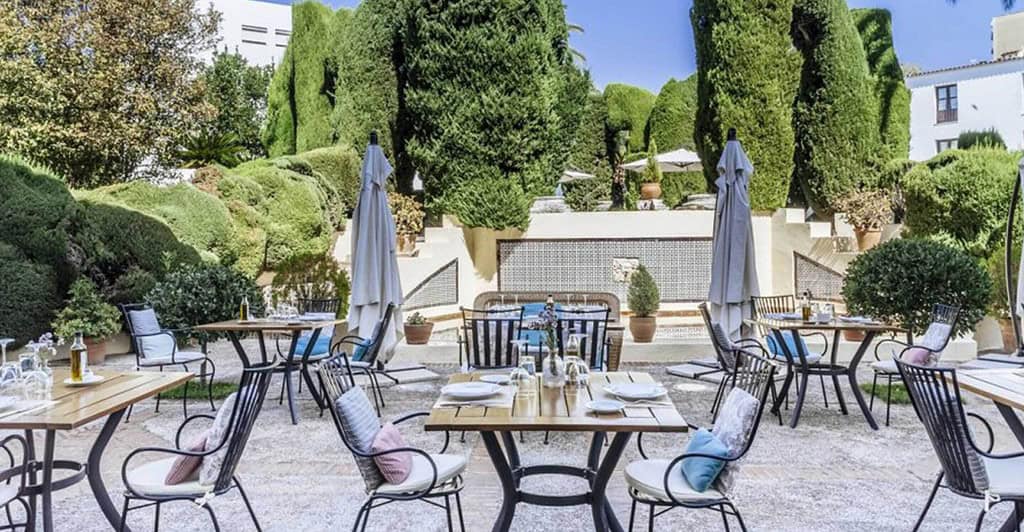
Parador de Mérida next to the Roman Ruins
Extensive Roman ruins are located steps away from the parador in Mérida, including a Roman theater and aqueducts. The parador building itself is a 16th-century convent with two beautiful interior courtyards. The rooms offer one-of-a-kind views overlooking the ruins.
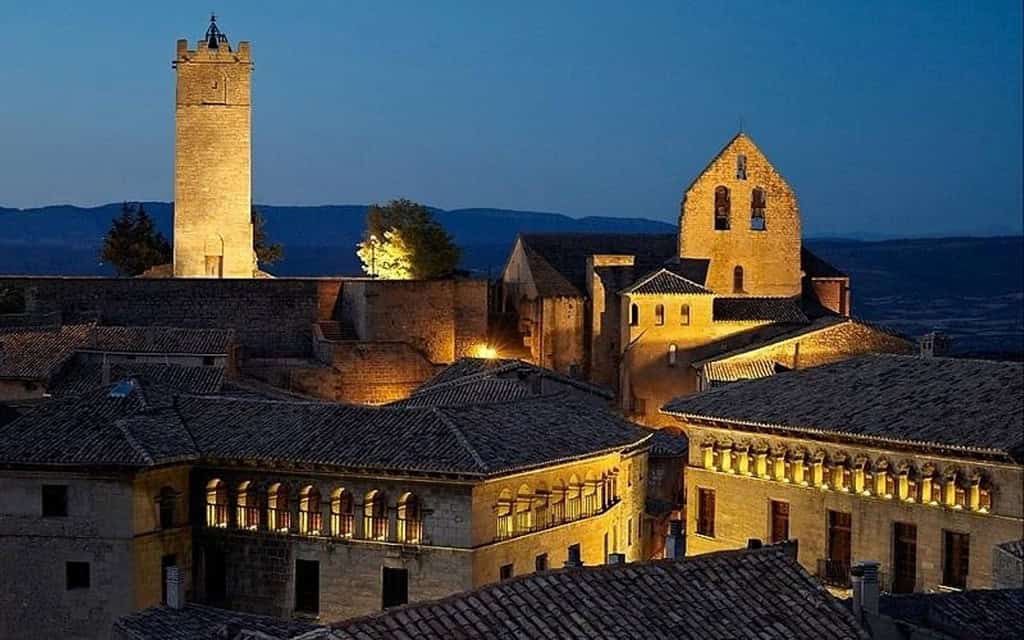
Parador de Sos del Rey Católico in an Imposing Castle
The impressive stone castle housing the Sos del Rey Católico parador dates back to the 15th century. The charming town of Sos del Rey Católico is filled with medieval, Jewish, and palace architecture. The parador’s restaurant is excellent and the castle towers provide panoramic views over the countryside.
Search for Paradores
Search for more paradores with this map:
Spanish Hotels Paradores -Architecture and Design
One of the most alluring aspects of Spain’s paradores is the breathtaking architecture and design of the buildings. Many paradores are located in converted castles, monasteries, fortresses, and palaces – allowing guests to step back in time and experience the history and character of each unique location.
Some of the key architectural styles found in Paradores include:
Romanesque
Paradores located in buildings from the 10th-13th centuries often showcase Romanesque architectural details like rounded arches, vaulted ceilings, and thick stone walls. The Parador de Santo Estevo is a 12th century Benedictine monastery with classic Romanesque cloisters and arched colonnades.
Gothic
Paradors in Gothic structures feature high ceilings, pointed arches, large stained glass windows, and ornate stone carvings. The Parador de Oropesa is a 14th century castle with a dramatic Gothic hallway and tower.
Renaissance
Renaissance styles from the 14th-17th centuries include symmetrical facades, domed ceilings, and neoclassical columns. The Parador de Toledo has grand Renaissance architecture with decorative plasterwork and detailed frescoes.
Baroque
Paradors in Baroque buildings from the 17th-18th centuries are ornate and lavish, with gilded accents, carved wood ceilings, and lush murals. The Parador de Cáceres has an interior courtyard with Baroque details around its arcades and balconies.
Modernisme
Influenced by Art Nouveau, some Paradors have the elegant curves and natural shapes of Modernisme style. The Parador de Lerma has a grand stone staircase, decorative ceramic tiles, and stained glass windows in this unique style.
The Parador de Oropesa, for example, is a 14th century castle that overlooks the Tagus River. It has been beautifully renovated to maintain the original stone walls, arched walkways, and grand courtyards while seamlessly integrating modern comforts. Guests can wander the halls and grounds imagining days of old.
The Parador de Sos del Rey Católico lies within a medieval walled town in Zaragoza. The parador itself is a 15th century palace and fortress that has been restored in the Renaissance style. Original stonework mixes with regal tapestries and furnishings transporting guests to the glory days of its inception.
Other famous paradores housed in former religious centers allow a glimpse into Spain’s spiritual past. The Parador de Lerma occupies a former 17th century convent and features a church, cloister, and elegant courtyard open to the skies. The monks cells have been converted into cozy guest quarters.
No matter which parador you choose, a stay promises an immersion into Spain’s rich history through architecture and design that has endured for centuries. The local character of each region shines through while modern amenities ensure a comfortable visit.
Spanish Hotels Paradores -Dining
Paradores are known for their excellent dining options that highlight regional Spanish cuisine. Each Parador has at least one restaurant on-site, with most having multiple dining outlets. The restaurants use fresh, local ingredients and recipes to create authentic Spanish dishes.
The restaurants at Paradores range from formal dining rooms to casual cafes and tapas bars. The head chefs take great pride in presenting classic Spanish flavors and contemporary twists on regional specialties. You’ll find seafood paellas, hearty stews, cured ham, Manchego cheese, and local wines featured on most menus.
Some standout dining options at Paradores include:
- Alma de Caceres Restaurant at Parador de Caceres – Michelin-starred new Spanish cuisine
- Echaurren Restaurant at Parador de Calahorra – Excellent wine pairings with seasonal tasting menus
- El Figon Restaurant at Parador de Sto Domingo Bernardo – Classic roast lamb and suckling pig in a beautiful monastic setting
- La Cocina del Alma Restaurant at Parador de Corias – Stunning river views and shareable tapas plates
In addition to on-site restaurants, many Paradores offer bar service, light snacks, and refreshments by the pool during the daytime. So you can enjoy excellent food and drinks from morning to night at these distinctive lodgings.
Activities – Things to do at/near Spanish Hotels Paradores
Paradores offer a wide variety of activities for guests to enjoy during their stay. Many are located near top attractions and historic sites, making it easy to explore the surrounding area. Some popular activities include:
Hiking & Biking
Paradores near national parks or trails let guests explore Spain’s landscapes by foot or bike.
Many paths lead to scenic views, forests, and historic ruins.
Local Festivals & Events
Paradores often plan activities around local festivals, including wine tastings and craft demos.
These events give guests a chance to experience real Spanish culture.
Outdoor Excursions
Guests can enjoy horseback riding, fishing, boating, and more through Parador-arranged outings.
Many locations also offer pools, golf courses, or nature tours onsite.
Historical Tours
Guides offer tours of nearby castles, cathedrals, and museums.
Paradores often sit near UNESCO World Heritage Sites, perfect for history lovers.
Spa & Wellness
For relaxation, many Paradors have spas with massages, facials, hydrotherapy, and mineral pools.
It’s a peaceful escape from sightseeing.
Stargazing
Rural Paradores offer clear, star-filled skies away from city lights.
Some locations host guided stargazing nights with telescopes and expert guides.
Shopping Excursions
Paradores may arrange transport to local markets and artisan shops.
Guests can explore nearby towns and bring home handmade souvenirs.
With their excellent locations and abundant activity options, Paradores allow guests to fully experience the best of Spain’s culture, cuisine, nature and history.
Why Spanish Hotels Paradores are Unique
Paradores offer a unique lodging experience that can’t be found at ordinary hotels. Here’s what makes them special:
- Locations in historic and scenic buildings like castles, monasteries, and fortresses that have been repurposed into hotels while retaining historic architectural features. Many have been declared national monuments.
- Emphasis on showcasing the history, culture, and natural beauty of Spain through architecture, interior design, regional cuisine, and amenities.
- High-quality service and accommodations that meet luxury hotel standards while maintaining local charm.
- Celebrated restaurants serving traditional Spanish cuisine made from locally-sourced ingredients. Many Paradors have Michelin-starred restaurants on-site.
- Promotion of local culture through on-site museums, guided tours, activities like wine tastings or cooking classes, and immersive design details.
- Scenic locations that allow for exploration of Spain’s diverse landscapes, natural parks, and historic cities. Paradors make an ideal base for active vacations.
- Government-run operation that aims to spur regional tourism and economic development, with reasonable rates compared to luxury hotels.
Amenities Offered
Paradores are known for their luxurious amenities that pamper and delight their guests. Many paradores feature fine dining restaurants, lively bars, refreshing pools, rejuvenating spas, and event spaces to host special occasions.
Restaurants
The restaurants at paradores highlight the best of Spanish cuisine, using fresh local ingredients. Menus include traditional Spanish dishes like paella, tapas, and seafood. Some locations have multiple restaurants, like formal dining rooms and casual cafes. Many also offer regional specialties.
Bars
After dinner, guests can unwind with a drink at the bar. Paradores have bars stocked with local wines, beers, and spirits. Some bars have live music or entertainment in the evenings. Bars range from cozy pubs to chic lounge areas. The bar is a great place to mingle with other guests.
Pools
Taking a dip in the pool is a refreshing break, especially during Spain’s hot summers. Pools come in all shapes and sizes, from small plunge pools to freeform infinity designs. Some have poolside bars or restaurants. The pools have plenty of lounge chairs for relaxing poolside with a book.
Spas
Many paradores offer rejuvenating spa treatments to pamper guests. Spas provide massages, facials, body treatments, and more using high-end products. Guests can book packages or individual services. Spas have serene treatment rooms, saunas, and relaxation lounges.
Event Spaces
Paradores have sophisticated event venues for hosting weddings, meetings, or special occasions. Grand ballrooms, intimate salons, and outdoor terraces provide unique settings. Experienced event staff help customize the details. Catering can be arranged from the on-site restaurants.
Room Types
Paradores offer a variety of room types to suit different needs and budgets.
Single Rooms
Single rooms at paradores are ideal for solo travelers. They contain one twin-size bed and are more compact than other room types. Single rooms are available at most paradores locations.
Double Rooms
These are the standard room type, containing either a large queen bed or two twin beds. Double rooms accommodate two guests comfortably. Some double rooms have the option to add a sofa bed to accommodate a third guest for an additional fee.
Suites
For more space, opt for a junior suite or suite. These rooms have a bedroom area as well as a separate living area. Some suites have two bathrooms. Suites are available at most larger paradores, particularly historic castle and palace locations.
Accessible Rooms
Many paradores have specially equipped rooms for guests with limited mobility. These rooms have wider doorways, handrails, and roll-in showers. Be sure to request an accessible room when booking if needed.
Spanish Hotels Paradores – Booking Tips
Booking a stay at a paradores can be done in several ways to find the best rates and packages. Here are some tips:
- Book early for best rates – Paradores offer dynamic pricing, so rates go up as availability goes down. Booking your stay early, even months in advance, will secure the lowest rates. Last minute deals can sometimes be found, but early booking is best for guaranteed low prices.
- Loyalty program – Frequent guests can join the Paradores Loyalty Program which provides additional discounts and perks. Accumulate points towards free nights, room upgrades, dining certificates and more.
- Look for packages – Many paradores offer packages that bundle the room with meals, activities and other amenities. Packages can offer savings compared to booking each component separately.
- Compare online and phone rates – It’s worth comparing rates offered on the official Paradore websites versus calling their reservation phone number. Online promos sometimes have lower prices, but calling allows you to ask about any current deals.
- Avoid third party sites – Booking directly through Paradores official channels will provide the best rates and perks. Third party sites often don’t have access to loyalty discounts or special offers.
Booking directly, looking for deals, and planning ahead are key to getting the best value on a paradores stay. Their unique historic locations make it worth finding a good rate!
Spanish Hotels Paradores – Sample Itineraries
Spain is a large country with many paradores spread out across different cities and regions. Here are some sample 3-5 day itineraries to help you plan your paradore-focused trip:
Northern Spain Paradore Route
- Day 1: Stay at Parador de Gijon on the northern coast. Explore the beaches and seaside promenade.
- Day 2: Head east to Parador de Santillana Gil Blas in Santillana del Mar. Tour the medieval old town and museums.
- Day 3: Continue east to Parador de Limpias near the Picos de Europa mountains. Enjoy hiking and nature.
- Day 4: Drive west to Parador de Santander on the Bay of Biscay. Relax along the waterfront.
- Day 5: Return to Parador de Gijon or head further west to Parador de Ribadeo.
Southern Spain Paradore Route
- Day 1: Stay at Parador de Carmona in sunny Andalusia. See the Roman ruins and view from Torre del Oro.
- Day 2: Visit Parador de Ronda dramatically set atop the El Tajo gorge. Walk the historic Puente Nuevo bridge.
- Day 3: Relax at Parador de Nerja on the Costa del Sol with lovely Mediterranean beaches.
- Day 4: End in Granada at the incredible Alhambra Parador, a palace and fortress complex.
- Day 5: Add on an extra day in Granada to fully explore the Alhambra.
Central Spain Paradore Route
- Day 1: Start at Parador de Almagro near La Mancha. Visit castles and windmills made famous by Don Quixote.
- Day 2: Head north to Parador de Alcala de Henares near Madrid. Tour the birthplace of Cervantes with cobblestone streets.
- Day 3: Drive west to historical Parador de Segovia with a fairytale castle and Roman aqueduct.
- Day 4: Finish in Avila at Parador de Avila. Admire the medieval walls and cathedral.
- Day 5: Add on Madrid or Toledo to further explore the region.
Spanish Hotels Paradores – Nearby Attractions
Many Paradors are situated in prime locations surrounded by incredible sights and landmarks for you to explore. Staying at a Parador gives you convenient access to discover the culture, nature, and history just steps away.
Alhambra and Generalife Gardens – Parador de Granada
The magnificent Alhambra palace and fortress complex dates back to Moorish rule in the 1300s. Meander through the intricate architecture and serene gardens for a glimpse into Spain’s Moorish past. The nearby Generalife Gardens provide a peaceful contrast with geometrical arrangements and water features.
Santiago de Compostela Cathedral – Parador de Santiago de Compostela
The iconic cathedral of Santiago de Compostela is the culmination of the famous Camino pilgrimage route. Admire the Romanesque and Baroque architectural details and take in the relics of St. James. Climb the stairs of the cathedral’s towers for panoramic views.
Aqueduct of Segovia – Parador de Segovia
The impressively preserved Roman aqueduct of Segovia towers over the city. Take a stroll alongside this engineering marvel from the 1st century AD. Get the best views of the aqueduct from Plaza Azoguejo.
Guggenheim Museum – Parador de Bilbao
The iconic Guggenheim Museum designed by Frank Gehry is a sight to behold just steps from the Parador. Admire the rippling titanium architecture housing a world-class modern art collection.
Special Events at Spanish Paradors
Paradores host exciting events all year that celebrate Spanish culture, food, holidays, and entertainment. From concerts to seasonal festivals, staying at a Parador lets you experience the country’s vibrant traditions up close.
Concerts and Music Festivals
Many Paradors host live music events that showcase Spanish musical styles and local talent. Flamenco guitar shows with singing and dancing are common, especially on warm evenings in outdoor courtyards. Select Paradors hold jazz or classical festivals that span several days. Larger sites, like the Parador de Granada, may feature headline concerts or music series. Smaller Paradors often invite local musicians for casual, intimate performances. These moments let guests enjoy authentic music without leaving the hotel. Keep an eye out for concert flyers or ask the front desk for details.
Local Holiday Festivities
Paradors celebrate Spanish holidays in fun and memorable ways. During Semana Santa (Holy Week), you can see religious parades or Passion Plays nearby. At Christmas, many Paradors decorate with festive lights, trees, and Nativity scenes. Some locations host holiday markets offering local food and crafts. On New Year’s Eve, enjoy music and dancing with fellow guests. Join the Spanish tradition of eating twelve grapes at midnight for good luck. Paradors also honor regional festivals like Andalusia Day or La Mercè in September. Staying at one lets you join in these local celebrations with ease.
Food and Wine Events
Spanish cuisine takes center stage during food events hosted by Paradors throughout the year. In autumn, truffle fairs offer tastings of seasonal dishes made with fresh truffles. Coastal Paradors may host seafood festivals to highlight local catches. During wine harvest season, enjoy tastings and pairings with regional wines. Some Paradors also offer cooking classes for guests. Learn to make paella, tapas, or traditional desserts using local ingredients. These experiences create lasting memories and deepen your connection to Spanish food culture. Ask your Parador about upcoming events during your visit.
Staying at a Spanish Parador offers much more than just a hotel stay. With music, festivals, food, and fun, these events create unforgettable cultural experiences for every traveler.
Spanish Hotels Paradores – History and Impact
The Paradores hotel chain began in 1928 under King Alfonso XIII to promote tourism in Spain. The idea was to convert historic buildings—like castles, palaces, and monasteries—into unique accommodations. This innovative plan boosted tourism and revived many small towns and rural areas across Spain. Building a Parador instantly put a destination on the travel map and brought it national attention. These iconic hotels became symbols of Spanish history, culture, and pride.
Today, the chain includes 97 hotels, with 13 more in progress. Paradores contribute over 175 million euros yearly to Spain’s economy and employ more than 7,000 staff. They attract both affluent international travelers and local tourists seeking authentic experiences.
Many Paradors house museums that tell the story of the building’s past. They offer guided tours and easy access to nearby historic landmarks. Restaurants on-site serve regional dishes made with fresh, local ingredients. This cultural immersion gives guests a truly unforgettable stay.
Looking ahead, Paradores will restore more historic buildings in need of care. Their focus is on sustainability and blending seamlessly into the natural environment. Though rich in history, the hotels offer modern amenities and technology to stay competitive. The timeless charm of Spain’s Paradors will continue to inspire future generations.
Further Reading
If you are interested in more Spain accommodation information, make sure to check out these posts: the Top 5 Spain Paradores you Must See, Book with Ease: Madrid’s Top 3 Airport Hotels Made Simple, and the 15 Best Hotels in Madrid You Need to Know About.
Packing Tips and Travel Tools
Dive into a variety of travel essentials and tips to enhance your next adventure. From safeguarding your phone with innovative waterproof pouches to selecting the most comfortable walking shoes for European streets, each article is designed to address specific travel needs and preferences. Whether you're planning a family trip to Europe, seeking stylish yet practical accessories like the Lululemon belt bag, or aiming to perfect your packing list, these guides will prepare you for a seamless and enjoyable journey.
Stay Cool and Stylish: What to Wear in Madrid in June
Discover the perfect blend of comfort and style with essential wardrobe recommendations for Madrid in June, ensuring you stay cool and fashionable while exploring the city's bustling streets and iconic landmarks.
Vacation in Style: The Ultimate Europe Trip Amazon Style Guide
Discover the perfect Europe summer outfits with our ultimate Amazon style guide, ensuring you dress to impress and make your summer bucket list aesthetic come to life.
The Ultimate Europe Packing List: Pack Like a Pro
Streamline your packing process and ensure you have everything you need for your European adventure with this comprehensive guide covering all the essentials to pack like a seasoned traveler.
The Best Kids Travel Gear for Europe
Equip your family for an unforgettable European journey with a curated selection of essential travel gear designed to enhance comfort, convenience, and enjoyment for children of all ages.
Safe and Stylish: Uncover the Magic of the Lululemon Belt Bag
Discover the perfect fusion of safety and style with insights into the functionality and allure of the Lululemon belt bag, a trendy accessory designed to enhance your everyday adventures.
How to Plan the Perfect Trip to Europe: Tips and Tools
Unlock the secrets to planning an unforgettable European adventure with comprehensive tips and essential tools, ensuring a seamless and enjoyable journey from start to finish.
Madrid Luggage Storage Tips: Making the Most of Your Visit
Maximize your time exploring Madrid hassle-free with expert tips on safely storing your luggage, allowing you to fully immerse yourself in the city's vibrant culture and attractions.
Never Get Your Phone Wet Again With These Waterproof Pouches
Explore a selection of innovative waterproof pouches designed to protect your phone from water damage, ensuring peace of mind during beach outings, rainy days, or water-based activities.
Guide to the Best Women's Walking Shoes for Traveling Europe
Discover the top picks for comfortable and stylish women's walking shoes essential for exploring the diverse landscapes and cobblestone streets of Europe with ease.
The information in this article is for informational purposes only and may not reflect the most current updates; please verify details independently before making travel plans. Always check with local sources before confirming your plans.
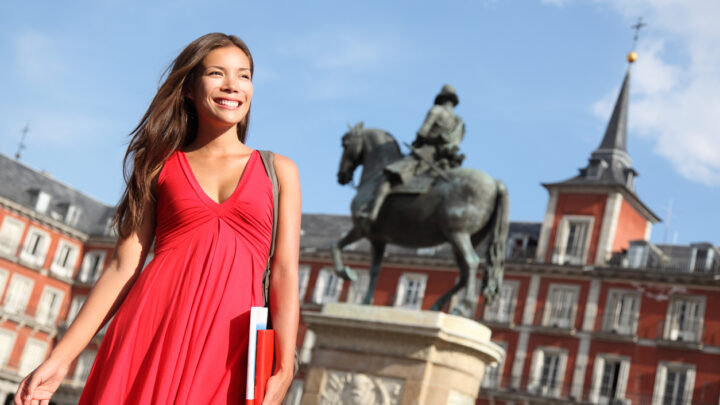








Comments Off on Discover Unique Spanish Hotels: Paradores – Lodging in Castles, Palaces, and Monasteries